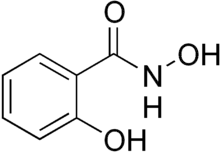Salicylhydroxamic acid
Salicylhydroxamic acid (SHA or SHAM) is a drug that is a potent and irreversible enzyme inhibitor of the urease enzyme in various bacteria and plants; it is usually used for urinary tract infections. The molecule is similar to urea but is not hydrolyzable by urease;[1] it thus disrupts the bacteria's metabolism through competitive inhibition. It is also a trypanocidal agent. When administered orally, it is metabolized to salicylamide, which exerts analgesic, antipyretic, and anti-inflammatory effects.
 | |
| Names | |
|---|---|
| IUPAC name
N,2-Dihydroxybenzamide | |
| Other names
2-Hydroxybenzenecarbohydroxamic acid | |
| Identifiers | |
3D model (JSmol) |
|
| ChEBI | |
| ChEMBL | |
| ChemSpider | |
| ECHA InfoCard | 100.001.759 |
PubChem CID |
|
| UNII | |
CompTox Dashboard (EPA) |
|
| |
| |
| Properties | |
| C7H7NO3 | |
| Molar mass | 153.137 g·mol−1 |
| Appearance | Brownish crystalline powder |
| Melting point | 175 to 178 °C (347 to 352 °F; 448 to 451 K) |
Except where otherwise noted, data are given for materials in their standard state (at 25 °C [77 °F], 100 kPa). | |
| Infobox references | |
Salicylhydroxamic acid is also a common ligand utilized in the synthesis of metallacrowns.
In plants, some fungi and some protists with the alternative oxidase (AOX) enzyme in the mitochondrial electron transport chain system, salicylhdroxamic acid acts as an inhibitor of the enzyme, blocking the largely uninhibited flow of electrons through AOX.[2] AOX acts as a "short circuit" of the normal electron chain, dissipating electrons with a much-decreased translocation of protons, and therefore diminished production of ATP by oxidative phosphorylation. When AOX is blocked by SHAM, electrons are forced through the cytochrome pathway and through complex IV, allowing observation of the operation of the cytochrome pathway without AOX activity. The AOX pathway is found to be the exclusive electron transport pathway in Trypanosoma brucei, the organism that causes African Sleeping Sickness, meaning that SHAM completely shuts down oxygen consumption by this organism.[3][4]
See also
References
- Fishbein, W; Carbone, P (1965). "Urease catalysis. ii. Inhibition of the enzyme by hydroxyurea, hydroxylamine, and acetohydroxamic acid". J Biol Chem. 240: 2407–2414. PMID 14304845.
- Anina D. Murphy & Naomi Lang-Unnasch (1999). "Alternative Oxidase Inhibitors Potentiate the Activity of Atovaquone against Plasmodium falciparum". American Society for Microbiology. 43 (3): 651–654. doi:10.1128/AAC.43.3.651. PMC 89175. PMID 10049282.
- Minagawa N; Yabu Y; Kita K; Nagai K; Ohta N; Meguro K; Sakajo S; Yoshimoto A (1997). "An antibiotic, ascofuranone, specifically inhibits respiration and in vitro growth of long slender bloodstream forms of Trypanosoma brucei brucei". Mol. Biochem. Parasitol. 84 (2): 271–80. doi:10.1016/S0166-6851(96)02797-1. PMID 9084049.
- Yabu Y; Yoshida A; Suzuki T; Nihei C; Kawai K; Minagawa N; Hosokawa T; Nagai K; Kita K; Ohta N (2003). "The efficacy of ascofuranone in a consecutive treatment on Trypanosoma brucei brucei in mice". Parasitol. Int. 52 (2): 155–64. doi:10.1016/S1383-5769(03)00012-6. PMID 12798927.